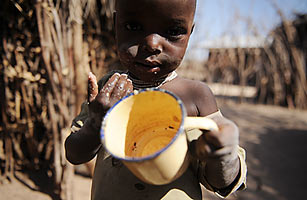
A Turkana boy holds an empty cup after breakfast in Lokwamosing village of drought-stricken Kenya.
When one enters the northern Kenyan village of Kalotum, the overwhelming impression is one of things missing. There are a dozen conical thatched huts and a clutch of spindly thorn trees. But there are no crops, animals or water. A quick look around reveals no men, either. "They all left," says villager Mary Atabo. She says just three of her family's 100 goats have survived a decade-long drought. With no animals to look after, the men have migrated to cities to look for work or sell what remaining possessions they have. "The weather comes and goes now," Atabo says. "We are left with nothing."
If the world's leaders need more inspiration before heading to the climate change summit in Copenhagen next month, they need look no further than East Africa. Here climate change is no longer a future threat — it is displacing and killing people today. In 2006, the United Nations said it expected Africa to be the continent most affected by climate change, not because it produces a large amount of greenhouse gases — quite the opposite — but because, as the world's poorest and most badly governed continent, it is the least equipped to cope with change. Around 90 million Africans were "at risk," it said, and that's not counting those impacted by wars and tribal conflicts, many of which are linked to extreme weather phenomena such as droughts and floods.
The U.N.'s predictions are already coming true. This year, around 23 million people in seven East African countries are being fed by aid agencies after a decade of poor rains have decimated crops. One of the worst-affected areas is the Turkana region in northern Kenya where Kalotum is located. In some communities here, up to 35% of the population is suffering from malnutrition, more than double the World Food Program's crisis threshold of 15%.
It's impossible to quantify how much of the change in rainfall is caused by man and how much is due to the cyclical patterns in nature. But it is clear that a significant change is afoot: a succession of productive growing seasons with predictable sun and rain has been replaced in recent years by a series of extreme weather events, leaving places like Turkana with little time to recover from one disaster to the next.
For example, severe storms over the past five weeks have dumped as much rain on parts of East Africa in one day as they normally see in a month, causing torrential floods. Part of the blame can be placed on the El Nino phenomenon, which is increasing in frequency due to global warming from once every seven years a few decades ago to every other year today. The Inter-Government Panel on Climate Change (IPCC) also said in a 2007 report that these types of droughts, storms and floods would become more common in the future, following one after another in rapid succession.
The locals have already noticed this happening. "The grass used to come up to my chest. There were wet and dry seasons. Now the weather has turned extreme and unpredictable," says Peter Aceh, 27, a tourist guide in the Turkana capital of Lodwar. Aid agencies warn that tens of thousands of people in Uganda, Somalia, Ethiopia and Kenya could end up displaced by the floods of the last few weeks. There have also been outbreaks of cholera in several countries.
Worse may be still to come. Eris Lothike, who works for the Oxfam relief agency in northern Kenya, says that if the rains swept away seedlings with the top soil and overstretched aid groups can't feed everybody, outright famine "is a looming possibility." And the 2006 Stern Review on global warming said that temperature rises in Africa could be more than double the global average over the next several decades, leading to severe water shortages and drastic reductions in crop yields in the future — and more famine.
As much as Oxfam and other aid groups stress the immediate humanitarian need of the people in the region, they are also pushing for more long-term agricultural assistance from the West to better prepare for climate change. Western aid "is still dominated by Band-Aids such as imported food aid," the group said in a recent report, "[which] saves lives now, but does little to help communities withstand the next shock." It has put forth proposals to channel aid money into farm productivity projects, the building of wells and grain storage facilities and the development of early-warning weather systems.
Even if such solutions do eventually arrive, it will not change the new climate reality in places like Turkana. Once, rain and sunshine were things to be celebrated. Now they are to be feared. This month, swarms of black flies began filling the air in northern Kenya, a sure sign of wet weather approaching. "The rains are coming," Atabo says. But too late. And probably too much.